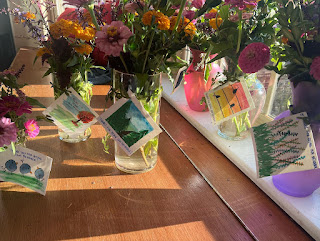Jenny and Sam Learn the ABCDs of Neighborhood Improvement
To better understand the differences between an asset-based and a deficit-based approach to a neighborhood, let's imagine two people (Jenny and Sam) living in the same neighborhood.
When Jenny looks around her neighborhood, she tends to notice problems first, but when Sam looks around the neighborhood, his eye is caught by all the gifts in the neighborhood.
Traditionally, most people who want to positively impact their neighborhood are like Jenny. The deficit-based approach is a common and understandable one. The desire to seek improvement often starts with seeing what's wrong.
When Jenny walks through her neighborhood, she sees needs, problems, and scarcity. As a result, Jenny feels overwhelmed at the thought of making a difference, so she invites an outside organization to come into the neighborhood and bring their expertise, resources, and volunteers. These are the hallmarks of a deficit-based approach.
But Sam sees assets, gifts, and possibilities there when he walks through the same neighborhood.
As a result, Sam feels hopeful at the prospect of making a positive difference and naturally invites his neighbors to pool their individual gifts to strengthen their neighborhood together.
These are the hallmarks of an asset-based approach.
This asset-based approach reveals hopeful possibilities that focusing on problems alone never would. It also puts power and ownership of the neighborhood in the hands of residents.
Jenny's deficit-based approach may solve a problem or two in the short term. In the long run, it leaves the neighbors marginalized, with all their gifts, insights, and wisdom untapped by the well-meaning experts and professionals from outside the neighborhood.
This deficit-based approach needs to be revised at best and potentially damaging at worst.
Sam's asset-based approach, on the other hand, not only makes a positive difference in the short term but also taps into his neighbors' gifts, insight, and wisdom in the process.
This collaborative effort leaves them empowered and engaged and hopeful for their neighborhood.
If we begin looking for people's gifts rather than people's needs, then things even better than we thought possible might materialize. If you want to improve a neighborhood, involve the people there.
Too often we begin by seeing only the things that are missing. We have to train ourselves to see the abundance. Ask people about their skills and interests and use those abilities in your neighborhood or community.
In 1993, John McKnight and John Kretzmann wrote, “Building Communities from the Inside Out: A Path Toward Finding and Mobilizing a Community’s Assets,” which started a revolution in community development by focusing not on what is wrong in the neighborhood but on what is strong instead.
The Hopeful Neighborhood Project is a great resource for an ABCD approach to neighborhood improvement. Find them online at https://www.hopefulneighborhood.org/





Comments
Post a Comment